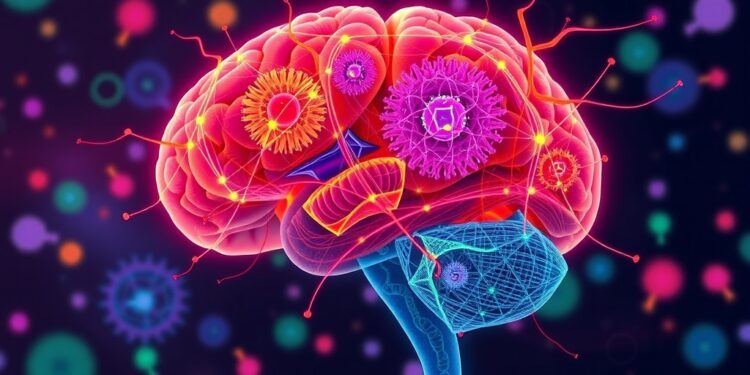In a remarkable example of the brain’s resilience and adaptability, the central nervous system deploys its immune cells, known as microglia, in response to injury. Not long after a collision sends someone to the ground with a head injury, a complex biological defense begins. Microglia, often regarded as the brain’s first responders, spring into action to remove cellular debris, clear toxins, and repair injured tissues. This dual role—acting as both protectors and potential aggressors—underscores the intricate balance these cells must maintain to promote neuronal function.
The findings of recent research from the Del Monte Institute for Neuroscience at the University of Rochester shed new light on how microglia operate within the context of sex differences. Microglia play a crucial role in both supporting neuronal health and contributing to neurodegenerative diseases when their activity becomes dysregulated. Traditionally, it was assumed that microglial function in adult males and females was largely uniform. However, this emerging study highlights that microglial activity is significantly influenced by sex, revealing a critical need for sex-specific research in understanding neurodegenerative diseases, including Alzheimer’s and Parkinson’s.
The Del Monte Institute researchers observed a differential response in microglia from male and female mice to an enzyme inhibitor, PLX3397, which is commonly utilized to deplete microglia in experimental settings. This inhibitor targets a specific receptor that signals microglial survival. In male mice, the administration of PLX3397 successfully reduced microglial populations, as expected. However, in females, the microglia exhibited a different survival signaling mechanism that enhanced their resilience, resulting in significantly less depletion of these protective cells.
This stark difference in microglial response between sexes opens up new avenues for investigating why certain neurodegenerative diseases show disparate prevalence rates in men and women. For instance, Alzheimer’s disease is diagnosed more frequently in women, while men are more often diagnosed with Parkinson’s disease. Understanding how these sex-specific responses to microglial signaling might contribute to disease susceptibility could revolutionize therapeutic approaches and lead to more tailored treatment strategies.
Ania Majewska, a leading researcher at the Institute and senior author on the study published in Cell Reports, emphasizes the broader implications of these findings for the field of neuroscience. The study explores the delicate interplay between microglia and their surrounding cellular environment, revealing not just the importance of microglia but also the need to consider sex as a significant variable in neurological research. Exploring the hormonal states or inflammatory environments under which microglia operate will be crucial for enhancing our understanding of their function in both health and disease.
In addition to its scientific contributions, this research challenges the long-standing notion that microglial behavior remains largely consistent across sexes in adulthood. The implications of these findings extend far beyond the laboratory, potentially influencing clinical approaches to Alzheimer’s and Parkinson’s disease. As researchers strive to develop effective disease-modifying therapies targeting microglia, recognizing and harnessing the nuances of sex-dependent microglial activity may lead to more effective interventions.
The study involved collaborative efforts within the Majewska Lab, where researchers documented the distinctive signaling pathways activated by PLX3397 in female versus male microglia. The mechanisms underlying these differences remain unknown, leading researchers to speculate on various factors, including hormonal influences and baseline states of inflammation, that may contribute to microglial behavior. This line of inquiry could pave the way for innovative research methodologies and clarify how these immune cells operate in different physiological contexts.
As neuroscience continues to unravel the complexities of the human brain, the discovery of different microglial responses further emphasizes the need for precision in research design. Recognizing the importance of sex as a variable could lead to breakthroughs that better reflect the biological realities of both male and female patients. The convergence of technology and biological investigation promises to deepen our understanding of microglial function and its implications for neurological disorders.
In the landscape of brain health research, microglia are increasingly positioned as pivotal players in the quest to combat neurodegenerative diseases. The role they play in modulating inflammation, signaling to other cells, and navigating cellular repair processes becomes even more critical when considering their variable responses across sexes. As we deepen our exploration into the signaling mechanisms employed by microglia, it becomes apparent that our understanding of brain health, injury, and disease must evolve.
Furthermore, additional research is needed to establish the clinical relevance of these findings. Future studies are likely to focus on delineating the pathways through which microglia exert their influence on neuronal health while considering the implications of sex differentiation in these processes. It is through such investigations that the scientific community can begin to formulate strategies aimed at preventing or mitigating the impact of neurodegenerative diseases.
Ultimately, the new insights into how microglia respond differently in males and females could significantly alter the trajectory of research in neuroscience. By embracing the complexity of the biological systems at play, researchers may uncover potential therapies that not only acknowledge but capitalize on the distinct cellular behaviors seen in different sexes, leading to improved outcomes for patients suffering from neurodegenerative conditions.
Understanding microglial dynamics in this sex-specific framework will be essential as the field contemplates newer therapeutic strategies. In time, the dialogue surrounding gender in medical research could shift paradigms and drive critical advancements in both our understanding and treatment of significant neurological health challenges.
As science progresses, the integration of molecular and cellular research findings with clinical applications will be vital in advancing personalized medicine approaches. The Del Monte Institute’s study serves as a foundation for these efforts, unlocking new perspectives in understanding how to navigate and manipulate the biological responses of immune cells within the nervous system.
In conclusion, as researchers delve deeper into the intricate responses of microglia based on sex, we may find ourselves on the cusp of transformative changes in how neurodegenerative diseases are understood, studied, and treated. The eventual outcomes of such research may not only enhance our grasp of brain health but also forge pathways towards revolutionary interventions for conditions that impact millions worldwide.
Subject of Research: Microglial Response to Injury in Male and Female Mice
Article Title: Research Highlights Sex Differences in Microglial Response to Injury
News Publication Date: 21-Jan-2025
Web References: Del Monte Institute for Neuroscience
References: Majewska, Ania, et al. “Microglia Respond Differently to Enzyme Inhibitor in Male vs. Female Mice.” Cell Reports, 2025. DOI: 10.1016/j.celrep.2024.115176.
Image Credits: University of Rochester Medical Center
Keywords: Microglia, Neurodegenerative Diseases, Alzheimer’s Disease, Parkinson’s Disease, Sex Differences, Immune Response, Central Nervous System, Cellular Biology, Neuroinflammation, Hormonal Influence.
Tags: Alzheimer’s diseasecellular biologycentral nervous systemhormonal influencemicroglianeurodegenerative diseasesneuroimmune responseneuroinflammationParkinson’s diseasesex differencessex-specific researchtherapeutic strategies






